A Study on the Evaluation of Effective Properties of Randomly Distributed Gas Diffusion Layer (GDL) Tissues with Different Compression Ratios
Abstract
1. Introduction
2. Fourier Series-Based Homogenization Method Materials
3. Modeling and Analysis Method
3.1. Generating a Fiber Network for Verification of the Proposed Homogenization Technique
3.2. Generating Fiber Network of Unit-Cell for Different Compression Ratios
3.3. Boundary Conditions in the Finite Element Model
4. Results and Discussion
4.1. Verification Results for Fourier Series-Based Homogenization Theory
4.2. Evaluation of Equivalent Properties of GDL for Different Compression Ratios
5. Conclusions
- A user run-script was developed using a homogenization technique based on the Fourier series to compute effective mechanical properties of GDLs with various compress ratios;
- Among the several homogenization theories, the homogenization theory with the Fourier series method is suitable to predict the effective mechanical properties of GDLs;
- The change of fiber volume fraction according to the compression ratio has a great effect on the longitudinal elastic moduli but relatively little effect on the shear elastic moduli;
- The fiber volume fraction increases sharply at the compression ratios of more than 30%, and then the effective mechanical properties and the stress/force behaviors rapidly change.
Author Contributions
Funding
Conflicts of Interest
References
- Ahn, J.; Park, S.H.; Lee, S.; Noh, Y.; Chang, D. Molten carbonate fuel cell (MCFC)-based hybrid propulsion systems for a liquefied hydrogen tanker. Int. J. Hydrogen Energy 2018, 43, 7525–7537. [Google Scholar] [CrossRef]
- Abdalla, A.M.; Hossain, S.; Azad, A.T.; Petra, P.M.I.; Begum, F.; Eriksson, S.G.; Azad, A.K. Nanomaterials for solid oxide fuel cells: A review. Renew. Sustain. Energy Rev. 2018, 82, 353–368. [Google Scholar] [CrossRef]
- Huang, Y.L.; Hussain, A.M.; Wachsman, E.D. Nanoscale cathode modification for high performance and stable low-temperature solid oxide fuel cells (SOFCs). Nano Energy 2018, 49, 186–192. [Google Scholar] [CrossRef]
- Inal, O.B.; Deniz, C. Assessment of fuel cell types for ships: Based on multi-criteria decision analysis. J. Clean. Prod. 2020, 265, 121734. [Google Scholar] [CrossRef]
- Ishikawa, H.; Teramoto, T.; Ueyama, Y.; Sugawara, Y.; Sakiyama, Y.; Kusakabe, M.; Uchida, M. Use of a sub-gasket and soft gas diffusion layer to mitigate mechanical degradation of a hydrocarbon membrane for polymer electrolyte fuel cells in wet-dry cycling. J. Power Sources 2016, 325, 35–41. [Google Scholar] [CrossRef]
- Weng, L.C.; Bell, A.T.; Weber, A.Z. Towards membrane-electrode assembly systems for CO2 reduction: A modeling study. Energy Environ. Sci. 2019, 12, 1950–1968. [Google Scholar] [CrossRef]
- Laoun, B.; Kasat, H.A.; Ahmad, R.; Kannan, A.M. Gas diffusion layer development using design of experiments for the optimization of a proton exchange membrane fuel cell performance. Energy 2018, 151, 689–695. [Google Scholar] [CrossRef]
- Carcadea, E.; Varlam, M.; Ismail, M.; Ingham, D.B.; Marinoiu, A.; Raceanu, M.; Ion-Ebrasu, D. PEM fuel cell performance improvement through numerical optimization of the parameters of the porous layers. Int. J. Hydrogen Energy 2020, 45, 7968–7980. [Google Scholar] [CrossRef]
- Jo, A.; Ahn, S.; Oh, K.; Kim, W.; Ju, H. Effects of metal foam properties on flow and water distribution in polymer electrolyte fuel cells (PEFCs). Int. J. Hydrogen Energy 2018, 43, 14034–14046. [Google Scholar] [CrossRef]
- Xing, L.; Shi, W.; Su, H.; Xu, Q.; Das, P.K.; Mao, B.; Scott, K. Membrane electrode assemblies for PEM fuel cells: A review of functional graded design and optimization. Energy 2019, 177, 445–464. [Google Scholar] [CrossRef]
- Park, J.; Oh, H.; Lee, Y.I.; Min, K.; Lee, E.; Jyoung, J.Y. Effect of the pore size variation in the substrate of the gas diffusion layer on water management and fuel cell performance. Appl. Energy 2016, 171, 200–212. [Google Scholar] [CrossRef]
- Kupgan, G.; Liyana-Arachchi, T.P.; Colina, C.M. NLDFT pore size distribution in amorphous microporous materials. Langmuir 2017, 33, 11138–11145. [Google Scholar] [CrossRef]
- Nishimura, A.; Sato, Y.; Kamiya, S.; Okado, T.; Yamamoto, K.; Hirota, M.; Hu, E. Impact of thickness of polymer electrolyte membrane and gas diffusion layer on temperature distributions in polymer electrolyte fuel cell operated at temperature around 90 °C. J. Energy Power Eng. 2019, 13, 97–115. [Google Scholar] [CrossRef]
- Mahmoudi, A.H.; Ramiar, A.; Esmaili, Q. Effect of inhomogeneous compression of gas diffusion layer on the performance of PEMFC with interdigitated flow field. Energy Convers. Manag. 2016, 110, 78–89. [Google Scholar] [CrossRef]
- Ito, H.; Iwamura, T.; Someya, S.; Munakata, T.; Nakano, A.; Heo, Y.; Kitahara, T. Effect of through-plane polytetrafluoroethylene distribution in gas diffusion layers on performance of proton exchange membrane fuel cells. J. Power Sources 2016, 306, 289–299. [Google Scholar] [CrossRef]
- Ito, H.; Heo, Y.; Ishida, M.; Nakano, A.; Someya, S.; Munakata, T. Application of a self-supporting microporous layer to gas diffusion layers of proton exchange membrane fuel cells. J. Power Sources 2017, 342, 393–404. [Google Scholar] [CrossRef]
- Simon, C.; Hasché, F.; Gasteiger, H.A. Influence of the gas diffusion layer compression on the oxygen transport in PEM fuel cells at high water saturation levels. J. Electrochem. Soc. 2017, 164, F591. [Google Scholar] [CrossRef]
- Lee, J.; Chevalier, S.; Banerjee, R.; Antonacci, P.; Ge, N.; Yip, R.; Bazylak, A. Investigating the effects of gas diffusion layer substrate thickness on polymer electrolyte membrane fuel cell performance via synchrotron X-ray radiography. Electrochim. Acta 2017, 236, 161–170. [Google Scholar] [CrossRef]
- Kanchan, B.K.; Randive, P.; Pati, S. Numerical investigation of multi-layered porosity in the gas diffusion layer on the performance of a PEM fuel cell. Int. J. Hydrogen Energy 2020, 45, 21836–21847. [Google Scholar] [CrossRef]
- Toghyani, S.; Nafchi, F.M.; Afshari, E.; Hasanpour, K.; Baniasadi, E.; Atyabi, S.A. Thermal and electrochemical performance analysis of a proton exchange membrane fuel cell under assembly pressure on gas diffusion layer. Int. J. Hydrogen Energy 2018, 43, 4534–4545. [Google Scholar] [CrossRef]
- Jeon, D.H. Effect of channel-rib width on water transport behavior in gas diffusion layer of polymer electrolyte membrane fuel cells. J. Power Sources 2019, 423, 280–289. [Google Scholar] [CrossRef]
- Zhou, X.; Niu, Z.; Li, Y.; Sun, X.; Du, Q.; Xuan, J.; Jiao, K. Investigation of two-phase flow in the compressed gas diffusion layer microstructures. Int. J. Hydrogen Energy 2019, 44, 26498–26516. [Google Scholar] [CrossRef]
- Aldakheel, F.; Ismail, M.S.; Hughes, K.J.; Ingham, D.B.; Ma, L.; Pourkashanian, M.; Mith, R. Gas permeability, wettability and morphology of gas diffusion layers before and after performing a realistic ex-situ compression test. Renew. Energy 2020, 151, 1082–1091. [Google Scholar] [CrossRef]
- Cheema, T.A.; Kim, G.M.; Lee, C.Y.; Kwak, M.K.; Kim, H.B.; Park, C.W. Effects of composite porous gas-diffusion layers on performance of proton exchange membrane fuel cell. Int. J. Precis. Eng. Manuf. Green Technol. 2014, 1, 305–312. [Google Scholar] [CrossRef]
- Hwang, Y.S.; Choi, H.; Cho, G.; Lee, Y.; Cha, S.W. Effect of compression thickness on performance of gas diffusion layer of direct methanol fuel cells. Int. J. Precis. Eng. Manuf. Green Technol. 2014, 1, 215–221. [Google Scholar] [CrossRef]
- Jeong, H.S.; Kim, J.I.; Lee, S.H.; Lim, C.H.; Ahn, B.K.; Kim, C.J. Analysis of Mass Transport in PEMFC GDL. Trans. Korean Soc. Mech. Eng. B 2012, 36, 979–988. [Google Scholar] [CrossRef]
- Chippar, P.O.K.; Kang, K.; Ju, H. A numerical investigation of the effects of GDL compression and intrusion in polymer electrolyte fuel cells (PEFCs). Int. J. Hydrogen Energy 2012, 37, 6326–6338. [Google Scholar] [CrossRef]
- Higgins, D.; Hahn, C.; Xiang, C.; Jaramillo, T.F.; Weber, A.Z. Gas-diffusion electrodes for carbon dioxide reduction: A new paradigm. ACS Energy Lett. 2018, 4, 317–324. [Google Scholar] [CrossRef]
- Mahnken, R.; Ju, X. Goal-oriented adaptivity based on a model hierarchy of mean-field and full-field homogenization methods in linear elasticity. Int. J. Numer. Methods Eng. 2019, 2, 277–307. [Google Scholar] [CrossRef]
- Voigt, W. Ueber die Beziehung zwischen den beiden Elasticitätsconstanten isotroper Körper. Ann. Physic 1889, 274, 573–587. [Google Scholar] [CrossRef]
- Hashin, Z.; Shtrikman, S. On some variational principles in anisotropic and nonhomogeneous elasticity. J. Mech. Phys. Solids 1962, 10, 335–342. [Google Scholar] [CrossRef]
- Willis, J.R. Bounds and self-consistent estimates for the overall properties of anisotropic composites. J. Mech. Phys. Solids 1977, 25, 185–202. [Google Scholar] [CrossRef]
- Mori, T.; Tanaka, K. Average stress in matrix and average elastic energy of materials with misfitting inclusions. Acta Metall. 1973, 21, 571–574. [Google Scholar] [CrossRef]
- Christensen, R.M.; Lo, K.H. Solutions for effective shear properties in three phase sphere and cylinder models. J. Mech. Phys. Solids 1979, 27, 315–330. [Google Scholar] [CrossRef]
- Eshelby, J.D. The Determination of the Elastic Field of an Ellipsoidal Inclusion, and Related Problems. In Proceedings of the Royal Society of London Series A, Mathematical and Physical Sciences, London, UK, 20 August 1957; Volume 241, pp. 376–396. [Google Scholar]
- Doghri, I.; Friebel, C. Effective elasto-plastic properties of inclusion-reinforced composites. Study of shape, orientation and cyclic response. Mech. Mater. 2005, 37, 45–68. [Google Scholar] [CrossRef]
- Doghri, I.; Tinel, L. Micromechanics of inelastic composites with misaligned inclusions: Numerical treatment of orientation. Comput. Methods Appl. Mech. Eng. 2006, 195, 1387–1406. [Google Scholar] [CrossRef]
- Tian, W.; Qi, L.; Chao, X.; Liang, J.; Fu, M.W. A new interpolative homogenization model for evaluation of the effective elasto-plastic responses of two-phase composites. Compos. Struct. 2019, 210, 810–821. [Google Scholar] [CrossRef]
- Guedes, J.; Kikuchi, N. Preprocessing and postprocessing for materials based on the homogenization method with adaptive finite element methods. Comput. Methods Appl. Mech. Eng. 1990, 83, 143–198. [Google Scholar] [CrossRef]
- Moulinec, H.; Suquet, P. A FFT-based numerical method for computing the mechanical properties of composites from images of their microstructures. In IUTAM Symposium on Microstructure-Property Interactions in Composite Materials; Springer: Dordrecht, The Netherlands, 1995; pp. 235–246. [Google Scholar]
- Ghosh, S.; Lee, K.; Moorthy, S. Multiple scale analysis of heterogeneous elastic structures using homogenization theory and voronoi cell finite element method. Int. J. Solids Struct. 1995, 32, 27–62. [Google Scholar] [CrossRef]
- Miehe, C.; Schotte, J.; Lambrecht, M. Homogenization of inelastic solid materials at finite strains based on incremental minimization principles. Application to the texture analysis of polycrystals. J. Mech. Phys. Solids 2002, 50, 2123–2167. [Google Scholar] [CrossRef]
- Esbati, A.H.; Irani, S. Mechanical properties and fracture analysis of functionalized carbon nanotube embedded by polymer matrix. Aerosp. Sci. Technol. 2016, 55, 120–130. [Google Scholar] [CrossRef]
- Müller, V.; Kabelm, M.; Andrä, H.; Böhlke, T. Homogenization of linear elastic properties of short-fiber reinforced composites—A comparison of mean field and voxel-based methods. Int. J. Solids Struct. 2015, 67, 56–70. [Google Scholar] [CrossRef]
- Aboudi, J.; Arnold, S.M.; Bednarcyk, B.A. Chapter 3—Fundamentals of the Mechanics of Multiphase Materials. In Micromechanics of Composite Materials; Butterworth-Heinemann: Oxford, UK, 2013; pp. 87–145. [Google Scholar]
- Luciano, R.; Barbero, E.J. Formulas for the stiffness of composites with periodic microstructure. Int. J. Solids Struct. 1994, 31, 2933–2944. [Google Scholar] [CrossRef]
- Nemat-Nasser, S.; Iwakuma, T.; Hejazi, M. On composites with periodic structure. Mech. Mater. 1982, 1, 239–267. [Google Scholar] [CrossRef]
- Lee, H. Multiscale Evaluation of Equivalent Mechanical Properties of Nonwoven Carbon-Fiber Fabric Composites; Chonbuk National University: Jeonju, Korea, 2017. [Google Scholar]
- Lee, H.; Choi, C.W.; Jin, J.W.; Huh, M.; Lee, S.; Kang, K.W. Homogenization-based multiscale analysis for equivalent mechanical properties of nonwoven carbon-fiber fabric composites. J. Mech. Sci. Technol. 2019, 33, 4761–4770. [Google Scholar] [CrossRef]
- Advani, S. Prediction of Fiber Orientation during Processing of Short Fiber Composites; ProQuest Dissertations Publishing: Ann Arbor, MI, USA, 1987. [Google Scholar]
- Nemat-Nasser, S.; Hori, M. Micromechanics: Overall Properties of Heterogeneous Materials; Elsevier: Amsterdam, The Netherlands, 2013. [Google Scholar]
- Barbero, E.J. Finite Element Analysis of Composite Materials Using Abaqus TM; CRC Press: Boca Raton, FL, USA, 2013. [Google Scholar]
- Jeong, J.Y.; Ha, S.K. Analysis of Micromechanical Behavior for Fiber-Reinforced Composites. Trans. Korean Soc. Mech. Eng. 2004, A28, 1435–1450. [Google Scholar] [CrossRef]
- Götz, T.; Klar, A.; Marheineke, N.; Wegener, R. A Stochastic Model and Associated Fokker-Planck Equation for the Fiber Lay-down Process in Nonwoven Production Processes. SIAM J. Appl. Math. 2007, 67, 1704–1717. [Google Scholar] [CrossRef]
- Grothaus, M.; Klar, A. Ergodicity and Rate of Convergence for a Nonsectorial Fiber Lay-Down Process. SIAM J. Math. Anal. 2008, 40, 968–983. [Google Scholar] [CrossRef]
- Holzer, L.; Pecho, O.; Schumacher, J.; Marmet, P.; Stenzel, O.; Büchi, F.N.; Münch, B. Microstructure-property relationships in a gas diffusion layer (GDL) for Polymer Electrolyte Fuel Cells, Part I: Effect of compression and anisotropy of dry GDL. Electrochim. Acta 2017, 227, 419–434. [Google Scholar] [CrossRef]
- Glatt, E.; Huber, F.; Enzmann, F.; Schaefer, T.; Wiegmann, A. GeoDict; The Digital Material Laboratory, Math2Market GmbH: Kaiserslautern, Germany. 2020. Available online: http://www.geodict.com (accessed on 21 October 2020).
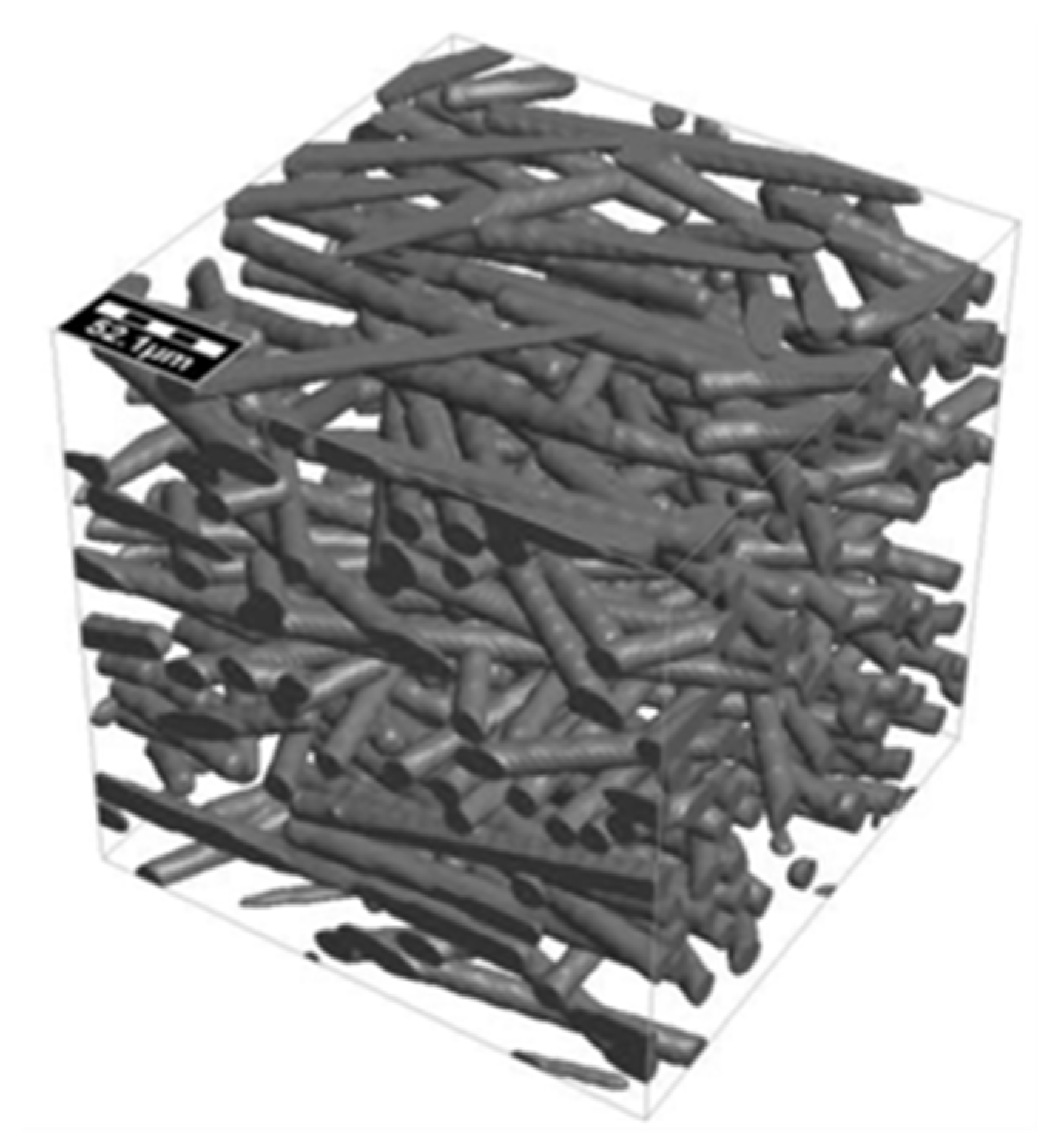
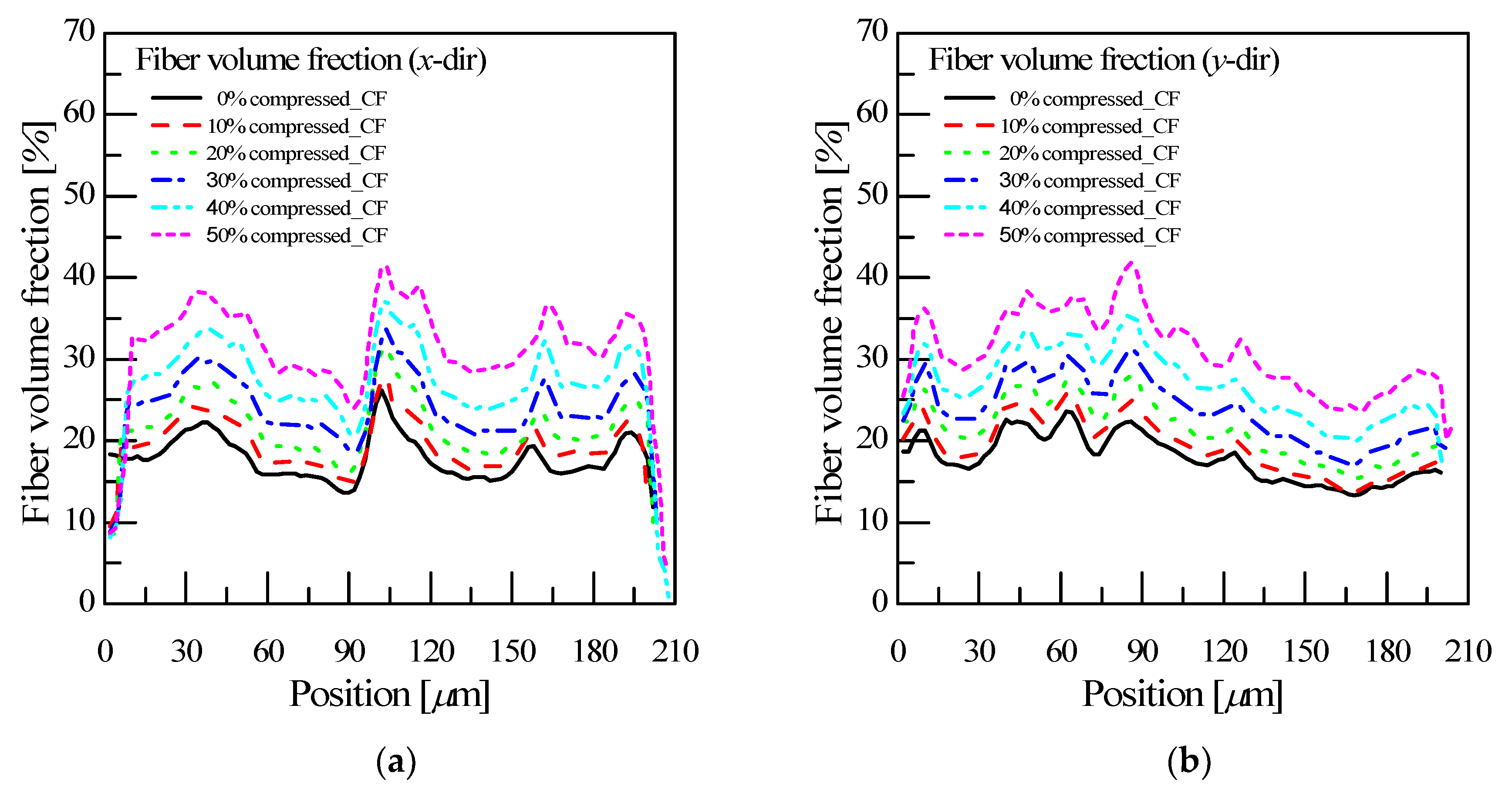
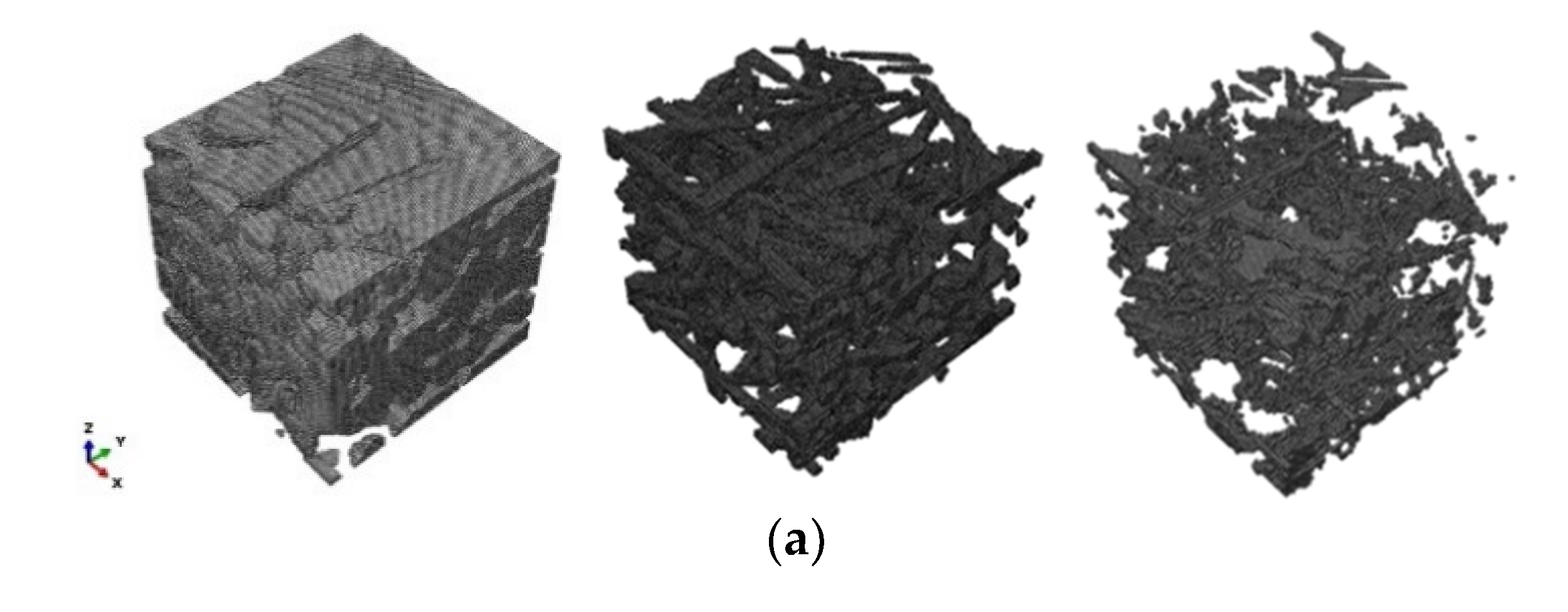

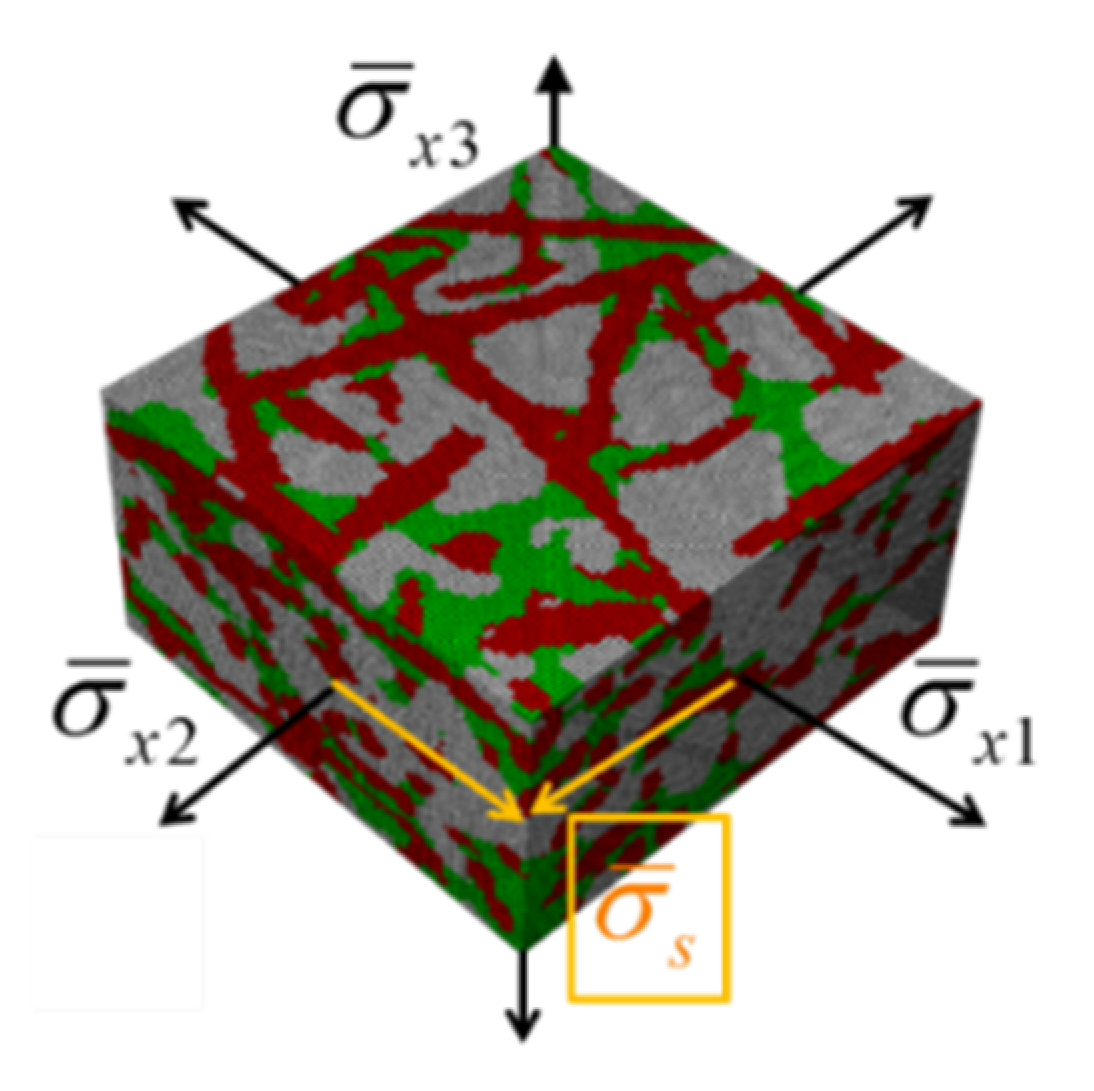
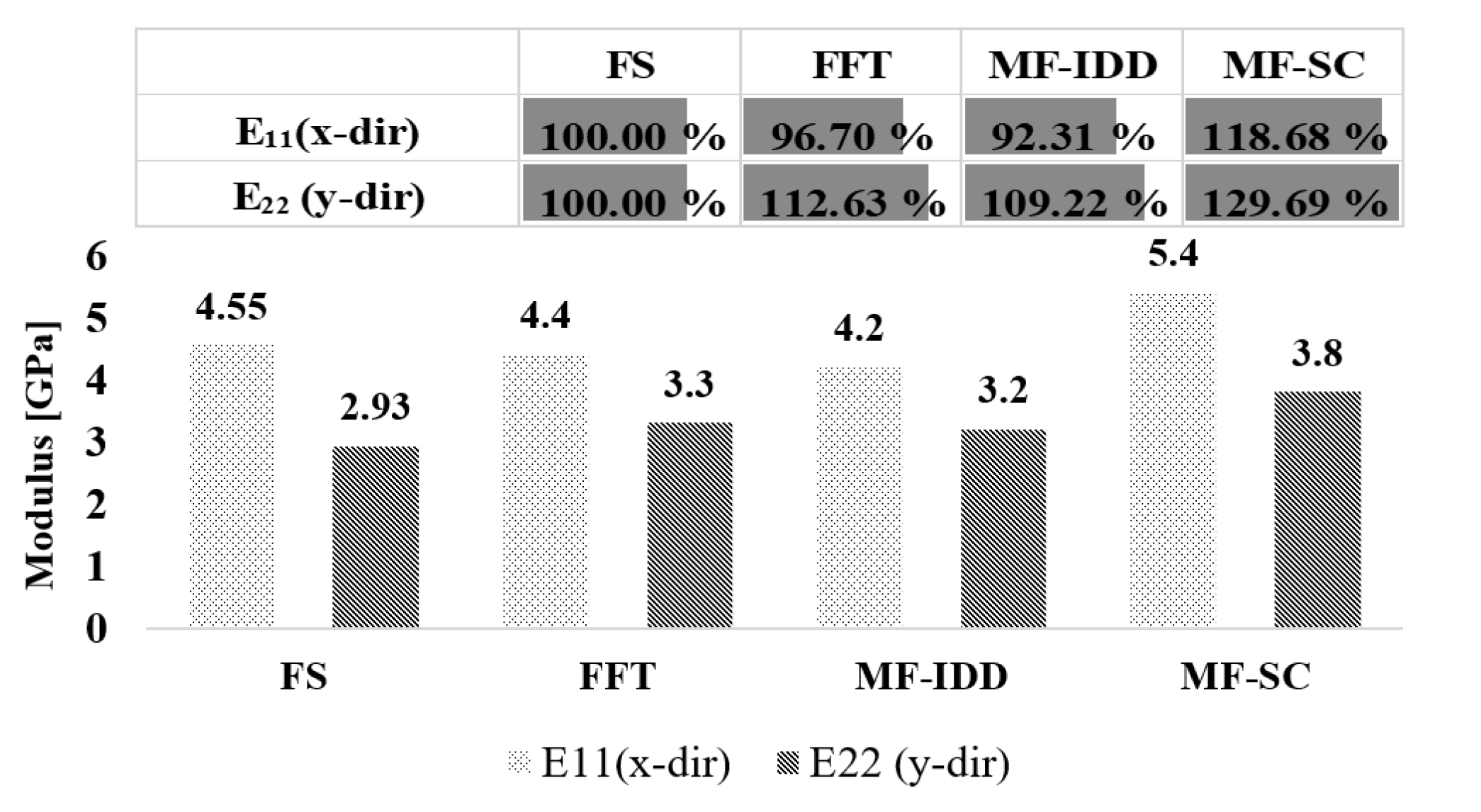
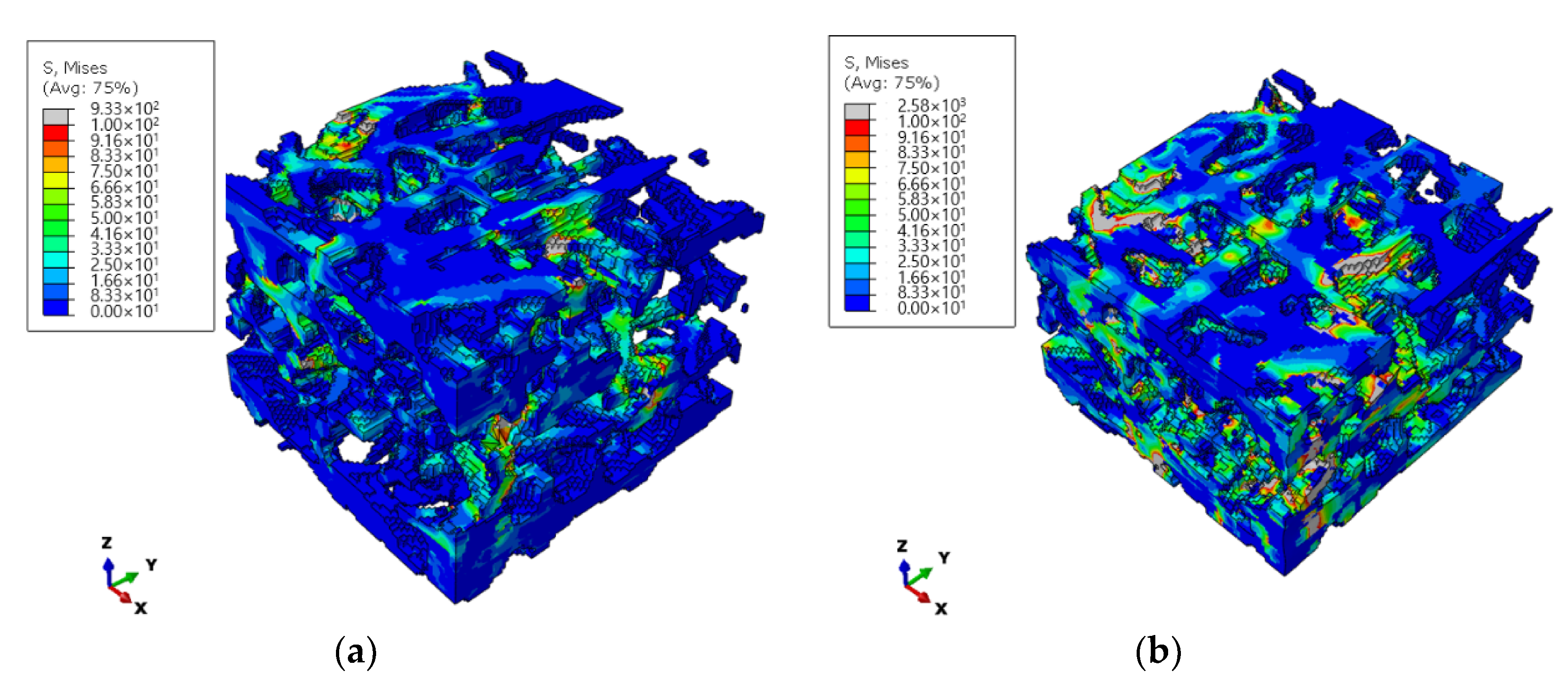
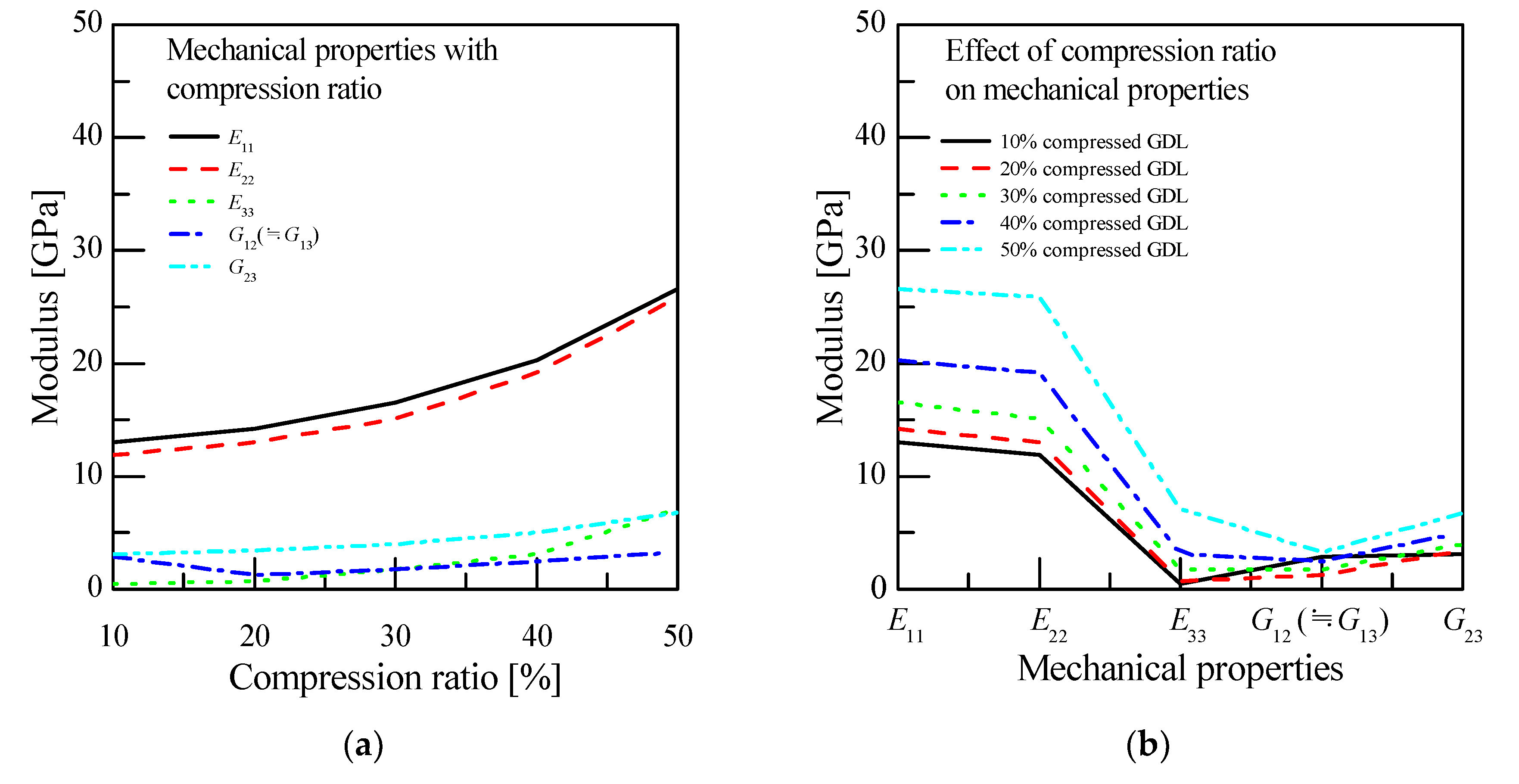
| Orientation Tensor | 1 | 2 | 3 |
|---|---|---|---|
| 1 | 0.61 | - | - |
| 2 | - | 0.36 | - |
| 3 | - | - | 0.03 |
| Orientation Tensor | 1 | 2 | 3 | |
|---|---|---|---|---|
| Original GDL model | 1 | 0.464 | - | - |
| 2 | - | 0.464 | - | |
| 3 | - | - | 0.072 | |
| 10% compressed GDL model | 1 | 0.464 | - | - |
| 2 | - | 0.467 | - | |
| 3 | - | - | 0.069 | |
| 20% compressed GDL model | 1 | 0.461 | - | - |
| 2 | - | 0.471 | - | |
| 3 | - | - | 0.068 | |
| 30% compressed GDL model | 1 | 0.459 | - | - |
| 2 | - | 0.461 | - | |
| 3 | - | - | 0.080 | |
| 40% compressed GDL model | 1 | 0.454 | - | - |
| 2 | - | 0.454 | - | |
| 3 | - | - | 0.092 | |
| 50% compressed GDL model | 1 | 0.448 | - | - |
| 2 | - | 0.451 | - | |
| 3 | - | - | 0.101 |
| Original | 10% | 20% | 30% | 40% | 50% | |
|---|---|---|---|---|---|---|
| Porosity | 70.16 | 70.05 (∇0.11) | 65.85 (∇4.2) | 61.43 (∇4.42) | 55.59 (∇5.84) | 47.74 (∇7.85) |
| Fiber volume fraction | 17.89 | 19.79 (∆1.9) | 22.06 (∆2.27) | 24.94 (∆2.88) | 29.14 (∆4.2) | 35.04 (∆5.9) |
| Resin volume fraction | 11.95 | 10.16 (∇1.79) | 12.09 (∆0.17) | 13.63 (∆1.68) | 15.26 (∆3.31) | 17.22 (∆5.27) |
Publisher’s Note: MDPI stays neutral with regard to jurisdictional claims in published maps and institutional affiliations. |
© 2020 by the authors. Licensee MDPI, Basel, Switzerland. This article is an open access article distributed under the terms and conditions of the Creative Commons Attribution (CC BY) license (http://creativecommons.org/licenses/by/4.0/).
Share and Cite
Lee, H.; Choi, C.-W.; Kang, K.-W.; Jin, J.-W. A Study on the Evaluation of Effective Properties of Randomly Distributed Gas Diffusion Layer (GDL) Tissues with Different Compression Ratios. Appl. Sci. 2020, 10, 7407. https://doi.org/10.3390/app10217407
Lee H, Choi C-W, Kang K-W, Jin J-W. A Study on the Evaluation of Effective Properties of Randomly Distributed Gas Diffusion Layer (GDL) Tissues with Different Compression Ratios. Applied Sciences. 2020; 10(21):7407. https://doi.org/10.3390/app10217407
Chicago/Turabian StyleLee, Haksung, Chan-Woong Choi, Ki-Weon Kang, and Ji-Won Jin. 2020. "A Study on the Evaluation of Effective Properties of Randomly Distributed Gas Diffusion Layer (GDL) Tissues with Different Compression Ratios" Applied Sciences 10, no. 21: 7407. https://doi.org/10.3390/app10217407
APA StyleLee, H., Choi, C.-W., Kang, K.-W., & Jin, J.-W. (2020). A Study on the Evaluation of Effective Properties of Randomly Distributed Gas Diffusion Layer (GDL) Tissues with Different Compression Ratios. Applied Sciences, 10(21), 7407. https://doi.org/10.3390/app10217407






